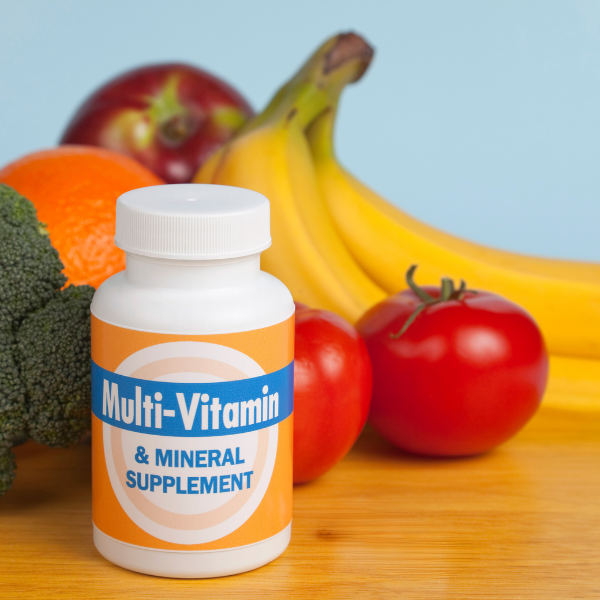
Brad King, MS, MFS
In recent years, the use of multivitamins has become widespread, with nearly one in three North Americans taking these supplements daily. People purchase these nutrient concoctions believing they will benefit their health in some way. However, a growing body of research indicates that the majority of multivitamins do not improve health or promote longevity and may even be somewhat harmful.
A recent study from the National Cancer Institute, published in JAMA Network Open in June, found that daily multivitamin use was associated with a 4% increase in mortality risk[1]. Like many other studies with primarily negative results, this one also used synthetically derived supplements. Any time you see a study using synthetic, isolated nutrients (i.e. not how they are found in food or nature) there is almost always a negative health outcome, yet none of these studies ever compare real whole food derived nutrients with their synthetic counterparts.
Understanding the differences between synthetic vitamins and those derived from real organic foods is crucial for making informed choices about our health and respecting the natural laws of nature, biochemistry and cellular biology[2].
Synthetic Vitamins - What You Need to Know
Isolation: Synthetic vitamins are isolated nutrients manufactured in a lab to mimic the molecular structure of natural vitamins. In other words, they may look the same under a microscope, but they do not behave the same inside our bodies (It’s pretty hard to fool millions of years of cellular evolution). Synthesizing nutrients from starting materials like petroleum[3] or genetically modified corn[4], and then delivering them in an isolated format, is unnatural and excludes the complex matrix of co-factors found in real foods[5].
Bioavailability: Synthetic vitamins are—more often than not—poorly recognized by the body, especially compared to natural whole food derived vitamins. They often lack the necessary co-factors that aid in absorption and utilization[6].
Label Indicators: Synthetic vitamins typically have chemical names ending in "ide", "ate" or “acid” (e.g., pyridoxine hydrochloride, thiamine mononitrate, ascorbic acid, folic acid). These names indicate a laboratory creation rather than a food-based source.
Whole Food Vitamins - What You Need to Know
Nutrient Synergy: Whole food vitamins come from natural sources such as fruits, vegetables, and mushrooms. They are part of a complex matrix of nutrients that work synergistically. For instance, vitamin C found in an orange is accompanied by bioflavonoids, enzymes, and other co-factors that enhance its effectiveness[7],[8], and vitamin E is found with eight isomers in food, rather than one[9].
Cellular Recognition: Our cells instantly recognize and utilize nutrients from whole foods more efficiently. These nutrients are delivered in forms and combinations that the body has evolved to process over millennia[10].
Label Indicators: Supplements derived from whole foods will list the actual foods they come from (e.g., acerola cherry, spinach, shiitake mushrooms) rather than chemical names (LeafSource® Real Multi).
Recognizing Synthetic Supplements
|
Aspect |
Synthetic Supplements |
Whole Food Supplements |
|
Label Indicators |
Chemical names ending in "ide," "ate," or "acid" |
Lists actual foods the nutrients are derived from |
|
Example |
Pyridoxine hydrochloride, thiamine mononitrate, ascorbic acid, folic acid |
Vitamin C from acerola cherry, vitamin E from sunflower seeds, folate from spinach |
|
Production |
Manufactured in labs from petroleum, acetone, isophytol, corn, etc., |
Extracted from real fruits, vegetables, and mushrooms |
|
Nutrient Delivery |
Isolated nutrients |
Nutrients delivered in a complex matrix with co-factors as found in nature/food |
|
Bioavailability |
Often less recognized and utilized by the body |
Easily recognized and utilized by the body |
The Dangers of Supraphysiological Levels
One of the pitfalls of synthetic supplements is the tendency to provide nutrients at supraphysiological levels - meaning many times higher than the recommended daily allowances (RDAs). While it might seem beneficial to get more vitamins, the body is not designed to handle such high concentrations[11]. Nutrients from real foods are supplied in much lower, yet more balanced levels, which the body can use more effectively.
Conclusion
So, while synthetic multivitamins are convenient, cost effective, and thereby the most widely sold by supplement manufacturers (profits anyone!?), from a cellular and biochemical perspective, they simply cannot offer the same benefits as vitamins derived from whole foods, which the body can instantly recognize and use. The natural complexity and synergy of nutrients in real whole foods are essential for proper absorption, transport and utilization.
When choosing supplements, it becomes vital to opt for those derived from real – preferably organic – foods (LeafSource® Real Multi), and avoid synthetic, isolated nutrients (in this case, otherwise known as chemicals). By doing so, we can better support our health at a cellular level, in a way that truly aligns with how our bodies naturally process nutrients. After all, you can’t fool the body no matter how many times you try!
References: